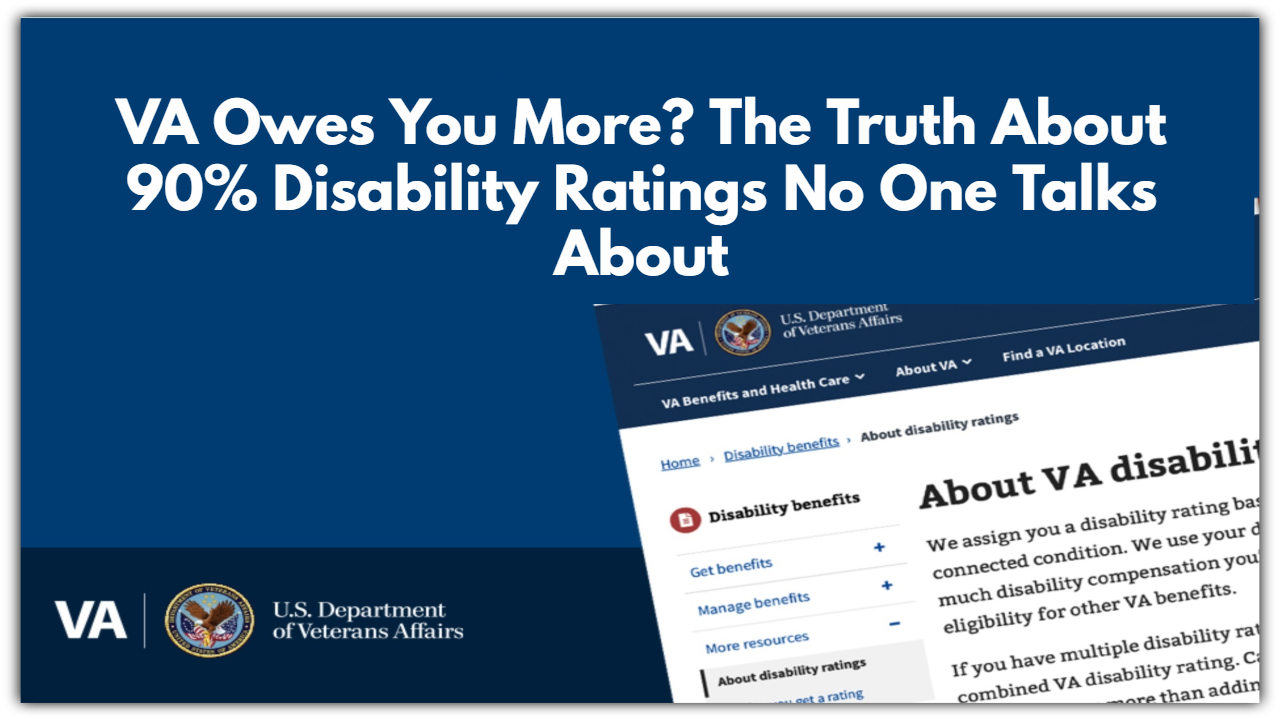VA Owes You More? The Truth About 90% Disability Ratings No One Talks About
If you’re a veteran with a 90% VA disability rating and no dependents, you might be thinking: “This is decent, but am I getting all I’m owed?” Or maybe “Why isn’t this considered 100%? I feel like I’m dealing with that kind of burden.”
You’re definitely not the only one asking.
Here’s the real talk version of what that 90% rating means for your monthly payment — and what other benefits might still be on the table.
What’s the Check Look Like Each Month?
Let’s get to the number most people care about first:
As of June 2025, if you’re sitting at 90% and don’t have any dependents (no spouse, no kids, no dependent parents), the VA should be sending you $2,297.96 every month, tax-free.
That amount includes the latest 2.5% cost-of-living adjustment (COLA) added late last year. It’s meant to keep up with rising prices — groceries, gas, rent — you name it.
So if that’s what you’re seeing in your bank account each month, great. If not, something may be off, and it’s worth checking into.
Wait… Only 90%? Why Not Round It Up?
You’ve probably wondered, “I’m at 90%. Why can’t they just give me 100%? What’s the big deal?”
Trust me, you’re not alone. A 90% rating isn’t just a little less than 100%—the gap in benefits is huge.
-
90% rating (no dependents): $2,297.96/month
-
100% rating (no dependents): $3,737.85/month
That’s a difference of over $1,400 per month. Not exactly pocket change.
But here’s the frustrating part: the VA doesn’t just add percentages together. They use this complicated “combined ratings” formula that ends up being a lot less generous than you’d expect.

But There’s a Workaround: TDIU
Here’s something a lot of veterans don’t know about: TDIU (Total Disability based on Individual Unemployability).
It’s a mouthful, but here’s the deal:
Even if the VA says you’re “only” 90%, if your service-connected conditions prevent you from working full time, you could get paid at the 100% rate. That’s $3,737.85/month.
You don’t have to be bedridden or completely disabled—just unable to hold down steady, gainful employment because of your condition(s). That’s it.
If you think that might apply to you, definitely look into filing for TDIU. You might already qualify and just not know it.
What About Other Benefits?
The monthly payment is only part of the story. A 90% disability rating opens doors to a lot of helpful stuff that often gets overlooked:
VA Healthcare (Top Tier)
You’re in Priority Group 1, which means:
-
Free medical care for service-connected issues
-
No copays for prescriptions
-
Better access to appointments
Home Loans
You qualify for VA-backed home loans with no down payment, no PMI, and way easier approval.
Job Help & Retraining
If working’s been tough, the VA offers Vocational Rehab (VR&E). It can help you retrain, go back to school, or even open a small business.
Commissary & Exchange Privileges
You can shop on base (in person or online) and save on everything from clothes to electronics — tax-free.
But What If I Don’t Have a Family?
That’s the setup we’re talking about here — no spouse, no kids, no dependent parents. So your payment is based strictly on you.
If that ever changes — like you get married or have a child — your benefit amount should go up. Just make sure to report any changes to the VA so you get what you deserve.
What Should You Actually Do?
Here’s a quick checklist to make sure you’re not leaving anything behind:
- Double-check that you’re getting $2,297.96/month (as of June 2025)
- Look into TDIU if working full-time is no longer realistic
- Explore other benefits (VA loans, free health care, education support)
- Talk to a VSO (Veteran Service Officer) — They’re free and can help walk you through everything
- Keep an eye on future COLA updates — New increases usually hit in December each year
A 90% VA rating without dependents is nothing to brush off. You’ve earned every dollar of that $2,297.96/month, and probably more. But if you’re struggling to make ends meet or keep a job because of your service-connected conditions, don’t settle.
Explore your options. Ask questions. Push for what you’ve earned.
You didn’t fight for the bare minimum—so don’t let the system give it to you.


Comments are closed, but trackbacks and pingbacks are open.